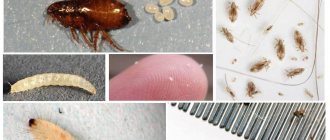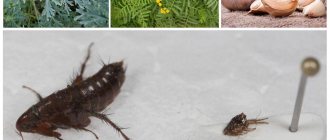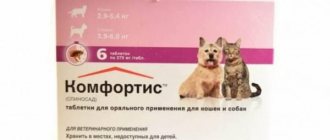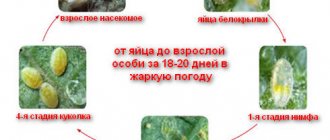A flea allergy in cats occurs as a response of the body to the presence of a large number of parasites. In most cases, an allergic reaction occurs with a weakened immune system and the presence of concomitant diseases.
A flea bite on a cat can not only lead to skin infections, but also cause an allergic reaction.
The first signs of allergies
In a cat, a flea allergy can occur in different ways, depending on the individual characteristics of the body. Some animals react more acutely, while others have milder symptoms. This depends on the number of parasites, the state of immunity and the age of the pet. Kittens are the most susceptible to allergies.
Allergy to flea bites in cats has the following primary symptoms:
- Severe skin itching. The cat is constantly itching, trying to get to hard-to-reach places by biting the skin with its teeth.
- The appearance of alopecia in certain areas. Inflammatory lesions appear on damaged skin, affecting the hair follicles. This leads to active hair loss.
- Formation of bumps on the skin. Papules appear in the place where the flea bites were. They begin to become inflamed, causing discomfort.
- Change in skin color, appearance of pigment spots.
- Severe swelling of the skin.
The cat develops dermatitis, which leads to severe cat itching and skin lesions. If the allergy is not identified and treated in a timely manner, the animal's condition will worsen. Associated symptoms will appear: cough and frequent sneezing, clear discharge from the eyes.
Where do fleas come from and how do they manifest themselves?
Unfortunately, even regular pet care cannot provide guaranteed protection against parasites. And we are even talking about cats, which caring owners do not let outside. As practice shows, parasites can be transmitted from one individual to another in many ways. Among the most common:
- frequent cat walks on the ground in which flea eggs are laid;
- contact of a healthy animal with an infected one;
- introduction of parasites into the house by people (people often bring flea eggs “with them” and, much less often, adult fleas).
Due to the variety of infection routes, even the most well-groomed pets can suffer from parasitic pests. If you allow your pet to walk on its own, the risk of flea infection automatically becomes one hundred percent. The number of insects that can simultaneously be on one cat is amazing: in particularly advanced cases, an animal can carry up to two hundred fleas.
First of all, you need to carefully monitor the behavior of the animal and the manner in which it cleans its fur. After a flea bite, the cat suffers from severe skin itching, but allergies are also possible. The result is particularly careful care of the pet's fur. Please note: if a cat washes itself much more often than usual and licks itself especially intensively, it will not be easy to detect parasites. The fact is that in this case they can jump off the cat while licking the fur, and then jump on. This is why many owners cannot identify insects even if they are present.
The most important point is the cat’s well-being. An animal suffering from fleas will itch furiously. First of all, insects attack the head and ears, as well as the most difficult places to lick. The most severe irritation is observed in the area of the tail, withers, along the spine, and also on the neck. A characteristic sign of a flea attack is redness covered with a thick crust. Parasites can also provoke rapid hair loss, the appearance of scarlet bumps and bald patches.
Be sure to inspect your pet's excrement. If helminths are detected in the stool, there can be no doubt about infection.
An equally characteristic sign of cat infection is a sudden change in habits and behavior. If an animal used to love to bask on a fluffy carpet, but now completely ignores woolen coverings and products, this is a very alarming signal. Groundless aggressiveness, anxiety, and irritability of a cat that is calm in temperament should also alert you. When insect bites are particularly painful, your pet may growl, violently shake its head, and meow loudly.
Change in animal behavior
In addition to visual manifestations on the skin and hair loss, the psycho-emotional state of the animal changes. Due to severe, incessant itching due to an allergic reaction, the cat’s appetite decreases or completely disappears. The pet does not walk, becomes passive, spends most of its time lying down, scratching its skin.
Some cats, instead of passivity and apathy, on the contrary, may behave differently: their irritability increases, excessive aggressiveness occurs, which increases even more when the owner tries to touch damaged areas of the skin. The reaction to stroking the fur is a pitiful, prolonged meow.
Signs of flea dermatitis in cats
Symptoms increase gradually over several days or weeks, but sometimes an immediate allergic reaction occurs. In such cases, signs of flea dermatitis appear suddenly, a few hours after the bite. The cat becomes restless and begins to scratch, lick and bite itself.
Symptoms:
- Constant itching leading to scratching.
- Hair loss and the appearance of small nodules, most often on the back, lower back, sacrum, abdomen and thighs.
- Weeping areas in the natural folds of the skin (groin, armpits).
- Areas of redness with papules that subsequently crust over
- Hyperpigmentation.
- Often scratches become contaminated with pathological microflora, causing bacterial or fungal infections that aggravate the animal’s condition.
- The cat behaves restlessly, and in severe cases the appetite worsens.
Consequences of allergies
Severe itching of the skin, which occurs in response to flea saliva, causes the cat to actively itch and bite the skin with its teeth. This leads to mechanical damage to the epidermis and the appearance of open wounds. As a result, a favorable environment for secondary infection is created. Infection aggravates the course of the allergy and can lead to the formation of large inflammatory areas in which pus accumulates.
The resulting wounds contain pathogenic fungi and bacteria, which are not at all easy to deal with.
Allergies also have an extremely negative effect on the animal’s immune system. Suppressed immunity reduces the body's resistance to various viruses and infections. The cat's general condition and behavior are only getting worse.
In addition, allergies can trigger the development of Quincke's edema. This is a complex pathological condition that can lead to the death of an animal due to suffocation.
The harmfulness of fleas
The degree of infestation of the kitten should be assessed; if there are few insects, it is better not to treat it with anything until it grows up, limiting itself to combing them out, because the potential harm from using an insecticide may exceed the damage caused by ectoparasites.
Fleas cause the following problems:
- Itching.
- Allergy to insect saliva.
- Anemia.
- Infectious diseases.
- Worm infestation. Immature larvae of some types of helminths live inside the flea. If an arthropod is accidentally ingested, it is digested, and the released parasite continues to develop in the body of a new host.
Diagnosis of the appearance of dermatitis
The owner can independently determine the presence of fleas in a pet by changing behavior and examining its fur. But only a veterinarian can make an accurate diagnosis - an allergy to parasites - based on the results of laboratory tests and examination of the animal. To clarify the primary diagnosis, a sample is taken from the affected area of the skin and examined. In addition, an allergen test is prescribed.
Allergic dermatitis as a negative reaction to a large number of fleas has similar symptoms to a number of other diseases. Therefore, differential diagnosis is required. Allergy to parasites must be distinguished from diseases such as lice, sarcoptic mange, alopecia, and pemphigus foliaceus.
Dermatitis is a skin reaction that is a symptom and not a disease itself.
How dangerous are fleas for cats and humans?
It has been known since ancient times that cat fleas can be carriers of a number of diseases that are most dangerous to humans. The greatest threat to life and health is posed by individuals that parasitize rats. It is they who are capable of infecting a person with such terrible diseases as typhus and plague, which was observed in the Middle Ages.
A cat infected with fleas suffers from sharply deteriorated mental and physical well-being. Quite often, parasite bites provoke allergic reactions and dermatitis. In addition, these insects carry worms. Ectoparasites are carriers of a dangerous disease for cats - hemobartonellosis. This disease leads to a sharp decrease in the content of red blood cells in the blood, which provokes the development of anemia. Fleas are the source of a number of fungal and viral diseases that affect internal organs and cause fever.
With a particularly complex clinical picture of infection, the animal suffers mentally and can almost completely and irrevocably lose its fur.
What to do first
Therapy for allergies to blood-sucking insects is complex. To begin with, it is important to quickly and completely remove fleas, and to stop signs of the pathological process and alleviate the pet’s condition, take medications.
Destruction of parasites
To remove parasites, it is recommended to use the following methods:
- The animal must be thoroughly washed with a special shampoo to kill fleas.
- Use a comb to comb the fur to remove parasite larvae.
- Apply a special product in the form of drops to the skin, which is aimed at killing fleas, ticks and other parasites.
- Give the cat an anti-worming tablet.
It is important to rinse off the foam very thoroughly; to do this, the wool is washed three times with clean water.
You cannot use a flea collar during therapy, as it can aggravate the pathological condition. This is due to the fact that the cat’s body reacts negatively to the chemical composition of the collar and the essential oils in its composition. This leads to cramps, nausea and severe, profuse vomiting, prolonged diarrhea and frequent fainting. Therefore, it is worn only as a preventive measure after the fleas have been destroyed with special means.
If necessary, all activities (bathing, combing, taking pills) are repeated. Although flea treatments for cats always give a positive result, if there are too many fleas, a repeat course may be required.
Home treatment
The house must be treated for fleas. They can jump from the animal's fur to pieces of furniture, remain on the carpet and then migrate back to the pet after it has been treated.
Treating your apartment for fleas is necessary to completely get rid of these insects.
For the home it is necessary to use special insecticides. You can buy them at a pet store. All upholstered furniture in the house, floor coverings, and carpets are subject to treatment. You also need to treat the floor, especially the baseboard. The cat mat on which the pet sleeps must be washed at high temperature.
If the animal lives in a private house and regularly goes out into the yard, the area needs to be thoroughly treated.
How are fleas detected on a cat?
Self-diagnosis is carried out as follows:
- First you need to pay attention to preparing the cat. Sit your pet on a light cloth to easily detect fleas and their eggs that have jumped off the animal. If you decide to brush your cat on your lap, be sure to place a cloth underneath it.
- Comb the coat thoroughly, from head to tail, using a special anti-flea comb. This device is designed in such a way that when an individual collides with a comb, it immediately gets stuck between the fine teeth. You should especially intensively comb the inner surface of the paws, the tail area, and the withers - the favorite habitats of parasites. Make sure that the combed insects do not end up on the floor or furniture.
- After brushing, inspect the cat's comb and fur. Even if no fleas were found during the process, you will probably notice their waste products - excrement and eggs. Visually they are presented in the form of dark and white “grains of sand”. So that there is no doubt, the combed material can be wrapped in a cloth moistened with water: once wet, the excrement will immediately acquire a scarlet color, as it is literally soaked in blood.
- Combing alone is not enough: a full diagnosis requires an immediate visit to the veterinarian. The doctor will carefully examine the cat for signs of infection, after which he will determine the exact diagnosis and treatment options.
Treatment regimens for cat allergies
Ridding an animal of parasites is not a sufficient measure to treat allergies. Depending on the symptomatic picture and the presence or absence of complications, appropriate drug therapy is selected.
Symptomatic therapy
For symptomatic treatment, drugs mainly from the hormonal pharmacological group are used:
- Prednisolone. The dosage ranges from 0.5 to 1 mg for every 1 kg of animal body weight. Prednisolone is used in tablet form.
- Dexaforte. The amount of the drug is 0.05 ml per 1 kg of weight. Dexaforte is used to treat animals that have excessive aggression due to allergies, and pets that spend a lot of time outdoors, where the risk of re-infection is high.
In addition, it is recommended to give antihistamines such as Tavegil, Zyrtec and Suprastin.
Prednisolone is a white or white with a slight yellowish tint crystalline powder in odorless tablets.
If a cat has constant access to the street, despite the treatment, she has a risk of re-infection with fleas and developing allergies. To avoid this, veterinarians recommend immunotherapy – introducing a small amount of an allergen into the animal’s body.
When a small amount of an irritating substance is constantly introduced into the body, the cat’s immune system begins to actively produce antibodies. Over time, their concentration increases, and the body ceases to be sensitive to the allergen.
Immune therapy in cats in 85% of cases gives a positive result, which consists in the complete elimination of allergies, even in the presence of fleas in the fur.
Antibiotics for severe cases
Antibacterial drugs are prescribed if the cat, due to an allergic reaction and severe scratching, has inflammatory processes (purulent) on the skin, and an infection has entered the wounds.
Antibiotics are substances that inhibit the growth of living cells, most often prokaryotic or protozoan.
Antibiotics for cats can only be prescribed by a veterinarian. Drugs with a wide spectrum of effects are used. The duration of the course is 14 days.
Skin restoration products
Allergies primarily negatively affect the condition of the coat: it loses its shine and strength, and actively falls out. Bald spots appear on it. Treatment of the pathological condition includes careful and proper care of the coat. To quickly return it to its normal state, special vitamin and mineral supplements are used.
They should contain fatty acids:
- Nordic Omega-3 Naturals;
- Medizinal Dorschlebertranl.
Additionally, special drops for wool are prescribed: Essential-6 or Allerderm.
If the owner feeds the cat with finished industrial products, it should be replaced with dry food, which contains all the elements necessary for hair restoration. Recommended foods with medicinal effects: Derma ProPlan Plus, Hill's z/d, Coat Formula and Royal Canin Skin.
Prevention of flea dermatitis
An effective means of preventing flea dermatitis is regular treatment of the animal with antiparasitic drugs or the use of flea collars. They should be used regardless of whether the cat goes outside, since flea larvae are carried indoors with the owners' shoes.
Regarding the diagnosis and treatment of flea dermatitis in cats in our clinic, you can contact veterinarians - dermatologists Oksana Anatolyevna Maykova, Ekaterina Sergeevna Novik
Brief description of the disease
Flea dermatitis is an insect allergy or intolerance to parasite bites. Digging into the skin, the bloodthirsty parasite injects saliva, which prevents blood clotting and, when it gets into it, causes severe intoxication. This colorless liquid contains about fifteen different substances that cause unbearable itching.
In general terms, dermatitis is severe skin irritation caused by allergens. According to statistics, the majority of such reactions in dogs (about 80%) are caused by these small blood-sucking reptiles.
This disease usually affects animals between two and six years of age. Puppies under six months of age are not susceptible to this scourge, since their immunity is too weak and will not give a strong response to the allergen.
Symptoms of the disease
In total there are about two thousand species and subspecies of fleas. Most of them are parasitic throughout the body, however, a few varieties live exclusively on the face, on and around the ears. Usually, it is almost impossible to notice these tiny creatures with the naked eye, unless the condition of the infected animal has become critical.
As noted earlier, many skin diseases are caused by flea attacks. According to French researchers in 1992, the breeds most susceptible to the saliva of these bloodsuckers are:
- setter;
- fox terrier;
- chow-chow;
- Pekingese;
- spaniel.
There are other equally allergic dogs, such as pit bulls and sharpeis.
The clinical manifestations of parasite infection will depend not only on the sensitivity of the animal, but also on the number of insects on its body. The main signs of infection are:
- restlessness, irritability, barking, whining;
- dry skin, the appearance of peeling and crusts;
- itching, accompanied by endless scratching and licking of the affected areas;
- alopecia, bald patches, excessive hair loss;
- scratches, papules, weeping eczema;
- formation of fibrous nodes in the back, lower back, inner thighs and abdomen;
- hyperpigmentation and thickening of the skin;
- the pet noticeably loses weight and looks bad;
- in some cases, a worried dog refuses to eat and appears lethargic and lethargic.
It is important that even single bites provoke a strong allergic reaction, for example, while walking on the street. Only in 30% of cases do animals experience a slow increase in symptoms.
Treatment with folk remedies
When choosing how to treat a cat’s sores, you can turn to auxiliary folk methods. They can provide an additional effect, but cannot 100% replace drug therapy.
The following alternative medicines have proven themselves well:
- wormwood oil (repels fleas due to its pungent odor);
- turpentine solution (in a dosage of 50 ml per 10 liters of water);
- a mixture of garlic and brewer's yeast (for treating beds, carpets and upholstered furniture where the animal sleeps).
Wormwood oil
If your cat scratches the bites a lot, you can use a weak chamomile decoction to wash it - it soothes sensitive skin.
Before using any methods, you should consult your veterinarian.
Use of anti-flea products
Flea medications are a mandatory stage of treatment. They are available in the form of external agents (drops, sprays and ointments). When using them, you should not wash the animal frequently, as this reduces the effectiveness of the medicine.
Another form of release is tablets. Chewable pills are well absorbed by cats and have a quick effect, being absorbed into the blood and destroying parasites. For preventive purposes they are used once a month.
Your doctor should advise you on how to treat your cat's scratching. You should not prescribe the drug and dosage yourself.
Ways to control fleas
- No insecticides have been developed for kittens under 6 weeks of age. A limited number of anti-flea agents can be used with great caution from 1.5 to 3 months.
- Insecticides recommended for adults are safe for older kittens, except for flea collars.
The situation is complicated by the fact that if fleas are found on one baby, they will have to be expelled from littermates and the mother. Disinfestation of cats is carried out before mating, and during pregnancy and lactation they keep the premises clean. A nursing mother cannot be treated with usual means: the toxic substance will enter the suckling tract and cause poisoning.
Therefore, the fight against fleas in small kittens is divided into the following measures:
- Removing insects from the baby.
- Disinsection of the premises.











